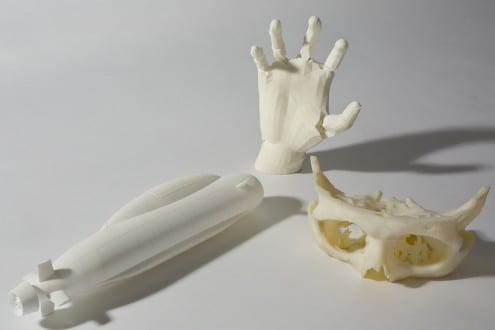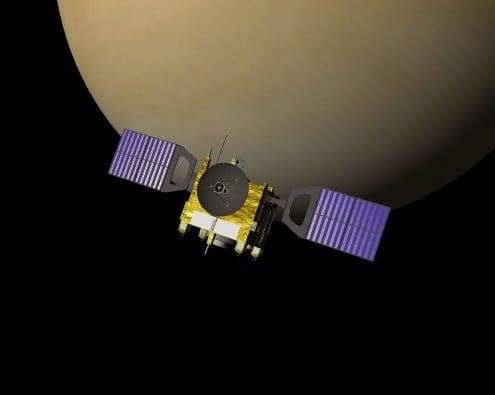Do neutrinos have mass? Anatomy of a scientific debate
By Oli Usher, on 7 August 2014
Do neutrinos have mass? And if so, how much? This apparently simple question has no simple answer and has been the subject of debate, controversy and confusion in the world of physics in recent years.
Neutrinos are subatomic particles created during certain types of nuclear reactions, including those that power the Sun. Although the Sun churns out neutrinos in unimaginably large numbers – around 80 octillion (8 followed by 28 zeroes) pass through the Earth every second – they are very hard to detect. Totally unaffected by electromagnetism, they are invisible and pass through matter unimpeded. They only interact gravitationally and, on the scale of atomic nuclei, through the weak nuclear force.
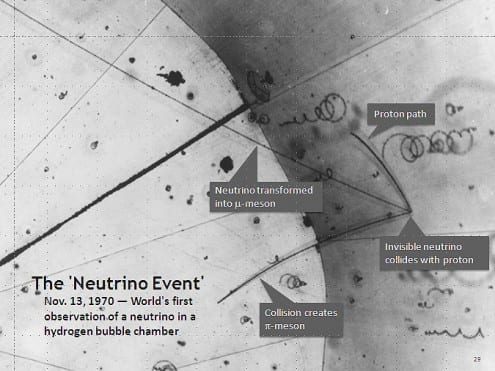
The first detection of a neutrino in a bubble chamber, in 1970. Photo credit: Argonne National Laboratory (public domain)
The framework of theories scientists use to explain and describe the world of subatomic particles, known as the standard model of particle physics, predicts that neutrinos, like photons, should have no mass. However experimental studies detecting solar neutrinos in recent years contradict this, suggesting that neutrinos do have mass.
So when data shows that a key element of your theoretical framework is proved wrong, what do you do? You could assume that the data are incorrect, or the theory is wrong. The consensus among physicists is that the standard model of particle physics is incomplete – but identifying what is missing from it is a complex issue.
Cosmologists are currently trying to get to the bottom of this question, with sometimes quite radical solutions. Boris Leistedt and Hiranya Peiris, two UCL researchers, have recently ruled out one of these eye-catching theories. The question won’t be settled until new data from a range of physics and cosmology experiments comes in a few years time. (Among these is the Dark Energy Survey, in which UCL is closely involved.)
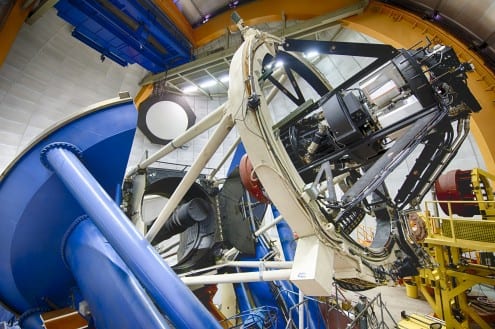
The Dark Energy Camera on the Blanco telescope in Chile will give new data on the structure and distribution of galaxy clusters in the universe. Photo credit: Reidar Hahn/Fermilab (All rights reserved)
But even before the new evidence comes in, the debate surrounding these claims and counterclaims cast light on how scientific theories develop.
***
The evidence that neutrinos have small (but non-zero) mass is now quite compelling, and scientists are in broad agreement that the standard model needs to be modified or extended to fit this new data. But how much mass they have and how much our theories needs to evolve are still open questions.
Finding the neutrino’s mass isn’t simply of academic interest. The mass of the neutrino is intimately tied up not only with the evolution of the standard model, but with our understanding of key issues in cosmology including the formation of galaxies, the way galaxies are scattered through the universe and the behaviour of the Big Bang.
Some recent studies of cosmological data have made waves this year, proposing a relatively high mass for the neutrino (of around twice the mass of previous estimates). These studies suggested that apparent discrepancies between several large datasets (including temperature fluctuations in the cosmic microwave background, the statistical distribution of galaxies through the universe, and X-ray detections of galaxy clusters) could be explained if neutrinos were heavier than previously assumed.

If the neutrino has a large mass, then several major datasets, including the Cosmic Microwave Background (above) can be reconciled with each other. But just because it is mathematically plausible doesn’t necessarily mean it’s true. Photo credit: NASA (public domain)
Statistically, these studies are quite compelling as they manage to reconcile apparently incompatible data, as well as addressing the key problem of the standard model by ascribing a mass to the neutrino.
But the results, despite tidying up loose ends, have not met with everyone’s approval. In particular, the UCL team think the evidence for neutrinos having such high masses is specious. They have recently published their thoughts on the subject.
They look at this apparent evidence for high-mass neutrinos from two different angles:
- First, if the neutrino is indeed heavy, what would that imply about the universe around us (and does it fit with what we see)?
- Second, if it is not, what else could explain the discrepancies in the data?
On both fronts, they think the evidence points firmly at a significantly lighter neutrino, in line with previous estimates.
***
Assuming that neutrinos have a relatively large mass fits experimental datasets quite well, but, Leistedt and Peiris argue, it is disproved by looking at a broader range of evidence.
The large-scale structure of the universe is dominated by gravity, much of it caused by an exotic (and invisible) type of matter known as dark matter. This governs the distribution, size, shape and motion of galaxies on unimaginably large scales, helping galaxies form, and clustering them together.
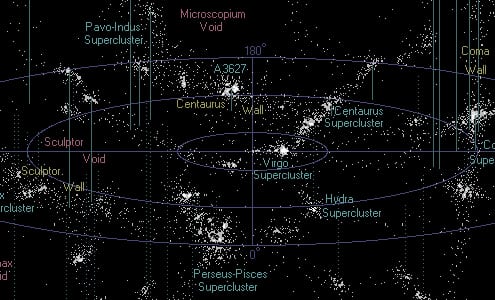
This map shows the location of galaxies within about 500 million light years of the Milky Way. Even on this scale – a tiny proportion of the universe – they are clearly bunched together in clusters and filaments. Photo credit: Richard Powell (CC-BY-SA 2.5)
A high mass for the neutrino would upset this balance, and in particular would inhibit the formation of galaxies like the one we live in, meaning there were fewer visible in the sky. It would also mean a less-structured universe on the scale of galaxy clusters and galaxy filaments. This is because very light neutrinos travel very quickly and pass through galaxies and clusters without any significant interaction, leaving them to form under the action of gravity. If neutrinos had higher mass (and hence lower velocities), they would interact far more, diffusing and scattering through galaxies and clusters, changing the way they collapse. In effect they would smear out the distribution of galaxies.
The distribution of galaxies through space seen by astronomers is extremely uneven, with filaments and sheets of galaxies surrounding huge voids, forming a vast cosmic web that fills the known universe. But the web is not consistent with what we would see if the neutrino had a high mass: structure would be washed out, voids would be larger, filaments thinner and galaxy clusters smaller.

Clustering of galaxies, as seen in this Hubble picture, would be much less pronounced if the neutrino had a large mass. Photo credit: NASA, ESA, HST Frontier Fields (public domain)
Moreover, the properties of the cosmic microwave background (the afterglow of the Big Bang) also undermine the idea of a high-mass neutrinos.
So, Peiris and Leistedt say, the models that propose a large mass for the neutrinos, which appear to fit the numbers quite well, turn out not to fit well at all with the individual data sets. The apparent agreement between them, they argue, is not much more than a statistical trick.
As an aside, some experiments have proposed higher-still masses for the neutrino, several times greater than even these controversial calculations. With neutrinos of that sort of mass, it is questionable whether galaxies would have been able to form at all and the universe would have been a dramatically different place.
***
Which brings us to the second question: if the discrepancies between different datasets can’t be explained by a heavier-than-expected neutrino, what does explain them?
Leistedt and Peiris think that this can be answered quite simply: actually most of the data broadly do agree with each other. It is the observations of how common galaxy clusters are in the universe which are out of line. And these are known to be the least robust of them all.
The unreliability, they argue, comes from multiple angles, including the difficulty of proving you have representative sets of galaxy data, the difficulty of knowing whether there is a selection bias in the data (e.g. large galaxy clusters being overrepresented), the difficulty of estimating cluster masses through gravitational lensing, and the extensive modelling involved which involves some degree of educated guesswork.

Gravitational lensing – the bending of the light from distant galaxies – can be used to estimate the mass of galaxy clusters (as the extent of the bending is directly proportional to the amount of mass present). Lensed light from distant galaxies is visible in this closeup of the Hubble picture above as streaks and arcs of light, most obviously the large diagonal streak of bluish light in the right-hand side of the image. But it is fraught with difficulties. Photo credit: NASA, ESA, HST frontier fields (public domain)
Strip this unreliable data out, and it is far from obvious that there even is an anomaly that needs to be explained – and the previous, lighter estimates of neutrino mass look far more plausible once more.
A crucial test of this assumption will come with the Dark Energy Survey, which will bring with it far more robust data on galaxy clusters, alongside measurements of the distribution and gravitational lensing of galaxies, which will cross-check this data. This should, hopefully, settle the controversy. The survey’s five year observing run began last year, with early data expected late in 2015. This early data should be enough to settle the issue, ahead of the final data release in 2017.
***
On one hand, Peiris and Leistedt’s refutation of the neutrino having a large mass seems to bring us back to square one. We still don’t have a terribly clear idea of what the neutrino’s mass is. We still have a hole in the standard model, because even if it is small, the neutrino does have mass. And we have just contradicted some research that appeared to reconcile some of the available facts.
But the practice of science is often like this, with bold predictions, competing claims and imperfect evidence.
And we’re not – quite – back where we started: a plausible theory has been ruled out, we now have a clear hypothesis about why the data had discrepancies, and there will soon be, in the form of the Dark Energy Survey, a tool to test this hypothesis.
The rival teams, at least for now, are sticking by their guns. Leistedt and Peiris think the Dark Energy Survey will prove them right.
Time will tell.
Related links
Heading to Mars… again!
By Oli Usher, on 4 August 2014
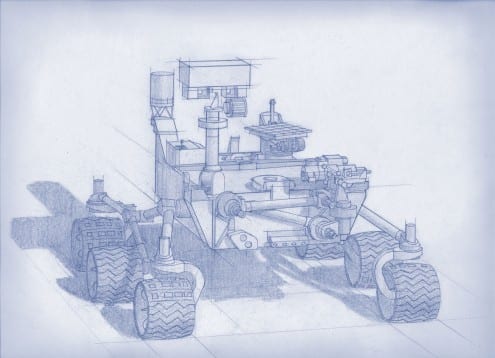
Artist’s concept of Mars 2020, a proposed NASA mission to Mars. UCL is part of the consortium building the stereoscopic camera. Photo credit: NASA (public domain)
Mars 2020 is a planned NASA Mars rover, which will be built to an almost identical design to the Curiosity rover currently exploring the Martian surface. NASA has just announced the scientific payload, and it will include Mastcam-Z – a stereoscopic zoom camera which will be built by a consortium that includes UCL.
Mastcam-Z is the pair of square ‘eyes’ on the bottom of the rover’s ‘head’ as shown on this diagram.

Labelled diagram showing the location of the instruments on Mars 2020, a proposed NASA mission to Mars. UCL is part of the consortium building the Mastcam-Z stereoscopic camera. Photo credit: NASA (public domain)
UCL are responsible for developing a test environment for laboratory simulations of stereo measurements, and deriving accuracy estimates for rover operations from this. Prof Andrew Coates (UCL Mullard Space Science Laboratory), who is one of the co-investigators (scientific leaders) on the project will also play a leading role in science requirements specification and exploitation, and comparison with other missions including ExoMars. His scientific focus will be atmosphere-surface interactions.
Many congratulations to the whole team, and in particular to Prof Coates, on this success.
UCL is already leading the consortium building PanCam, the main panoramic camera on the European ExoMars probe, which will launch in 2018.
We’ll check back in on the progress of both of these projects as the design, construction and testing moves forward.
Links
High resolution images
The oldest rocks on Earth
By Oli Usher, on 31 July 2014

A crystal of zircon (zirconium oxide). Credit: Denniss/Wikimedia Commons (CC-BY-SA 3.0)
The Earth is about 4.5 billion years old, but almost everything on its surface is much, much younger. Mountain ranges are formed and erode, oceans rise and fall, and the tectonic plates of our planet’s crust are constantly being subducted and renewed.
But there are still some surprisingly old rocks on the surface of the Earth.
In the Jack Hills region of Australia, geologists have found small crystals of zircon that can be dated to about 4.4 billion years ago – a period in which the young Earth was totally different to how it is now (it even had a partially molten still). These tiny minerals have survived largely unchanged for almost the entire history of the Earth, despite the total renewal of the rest of our planet’s surface in that time.
The Namib Sand Sea, a desert in south-west Africa, is another case in which geologists find surprisingly old minerals: in this case, grains of sand which have been sitting in the desert for over a million years. By comparison, many far more solid-looking features of Northern European landscapes, such as the rugged terrain of the Scottish Highlands, are less than 20,000 years old, having formed in the last glaciation.
In this video, Dr Pieter Vermeesch (UCL Earth Sciences) explains how geologists in the London Geochronology Centre at UCL are able to use cosmic rays from distant supernovae to calculate the age of the sand in the Namib Sand Sea.
Update – 06.08.14 – The Department of Earth Sciences has just published three further videos featuring Pieter Vermeesch talking about geochronology.
The ATLAS experiment at CERN
By Oli Usher, on 28 July 2014
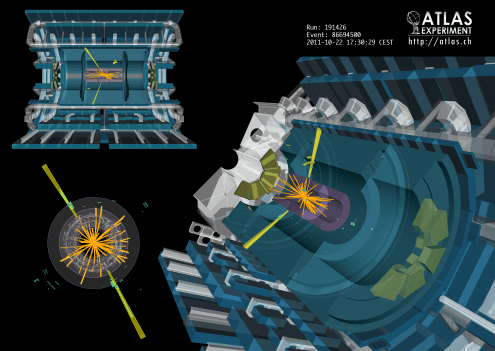
A two-photon event captured in the ATLAS experiment at CERN. This is one of the experiments that analyse particles accelerated and collided in the Large Hadron Collider, and played a key role in the discovery of the Higgs Boson. Photo credit: CERN (CC-BY-SA 4.0)
Peter Higgs, who predicted the existence of the Higgs Boson in the 1960s, is usually associated with the University of Edinburgh, where he spent most of his career. But we want to claim just a little credit for ourselves: Higgs briefly worked as a lecturer in UCL’s Department of Mathematics in 1960 (four years before postulating the existence of the particle that bears his name), and was awarded an honorary degree by UCL in 2010 (three years before winning the Nobel Prize in Physics). Clearly there is a correlation.
A more concrete and less contrived contribution by UCL to the discovery of the Higgs Boson comes from UCL’s involvement in the ATLAS experiment at CERN. Along with the CMS experiment (also at CERN), ATLAS finally provided concrete experimental corroboration of the existence of the Higgs particle in 2012.
A rendering of an experiment using ATLAS provides this week’s UCL Science Picture of the Week.
Numerous UCL physicists have been involved with the ATLAS project over the years, and when the collaboration’s paper setting out the evidence it had found for the Higgs Boson was published, 24 members of the Physics & Astronomy department were listed among the (many) authors on the paper.
Jon Butterworth, head of physics at UCL and a major participant in the ATLAS collaboration, will be hosting an evening of particle physics at UCL on 20 August 2014. Introducing the Large Hadron Collider, a virtual visit to CERN hosted by David Miller of Chicago University, a talk by TEDx speaker Lily Asquith about sonificiation of LHC data, and a Q&A session in which you can ask all your burning particle physics questions, the event is free and suitable for everyone from ages 12 up.
Links
- Booking page for ‘An Evening of Particle Physics’ with Prof Jon Butterworth
- ATLAS collaboration paper
- UCL Physics & Astronomy
- UCL High Energy Physics research group
High resolution image
- Download a high-resolution image from Flickr
- Download a high-resolution image from CERN Document Server
CERN have made available thousands of pictures, videos and photos of their work that are well worth checking out, all of which are totally free for educational and informational use. They even have a collection of photos – including this one – which are available under Creative Commons licences, which have even fewer restrictions on their reuse.
Picture of the week: X-ray speckles
By Oli Usher, on 21 July 2014
Counterintuitively, scrambling X-rays can help scientists make better X-ray images.
New research from an international collaboration including Pierre Thibault (UCL Physics & Astronomy) uses the random speckles of scrambled X-rays to produce improved images of objects when X-rays are passed through them.
The location and brightness of the speckles encodes information about the object being studied, allowing a detailed image to be reconstructed.
Today’s Picture of the Week shows the intensity (shown as the height and colour) and position of X-ray speckles detected in an experiment that was carried out as part of this research.
Photo credit: I. Zanette (TUM). This photo may be freely reproduced for the purposes of news reporting of this research, but it is not released under a Creative Commons licence.
Links
High resolution image
Another successful launch for UCL space technology
By Oli Usher, on 21 July 2014
The UK Technology Strategy Board’s TechDemoSat-1, featuring the UCL-built Charged Particle Spectrometer, was successfully launched from Baikonur in Kazakhstan on 8 July. A video of the launch is now available from Roscosmos.
Skulls, subs, and selective laser sintering
By ucqnklo, on 14 July 2014
We hear a lot about 3D printing as the future of manufacture, but it’s also finding many applications in research.
Today’s picture of the week shows three of the uses researchers at UCL Engineering are finding for additive manufacture.
On the left, a model submarine printed by a student in Naval Architecture lets them see their designs in 3D. In the middle, UCL computer scientists experiment with the exciting new problem of creating virtual models that can be printed out with movable, posable parts; and on the right, a section of 3D printed skull, recreated from scans by researchers at UCL Medical Physics based within UCLH, enables surgeons to plan their operations.

Just for fun: old school meets new tech: a chimp skull from UCL’s Bioanthropology Collections next to a high-tech 3D print of a modern human from UCL Medical Physics. Will 3D printed skulls be the future of anatomy teaching?
All of these models were printed using a method called Selective Laser Sintering (SLS). This is a kind of 3D printing that uses lasers to melt bits of a polymer powder together in the shape of a cross-section through the object you want to print. Then, a layer of power is added on top, and another layer melted. If it is resting on powder, that powder will just brush off when the plastic model is removed: if it is resting on a previously melted bit, it will stick to it.
This is a more expensive way to 3D print than the hobby-level 3D printers which are more commonly seen, which basically squeeze out layers of plastic like toothpaste, stacking them up into shapes . However, it allows the printing of more complicated shapes, with overhangs and interpenetrating parts – so it’s really handy for detailed research uses. UCL has a number of 3D printers, some free for all our staff and students to use in our open access Makespace.
Links
- 3D printing of non-assembly, articulated models – by Cali et al at UCL Computer Science
- Naval Architecture MSc at UCL
- UCL Medical Physics & Biomedical Engineering newsletter: article on ‘Facing up to disfigurement’ on pg 5
- UCL Institute of Making MakeSpace
High resolution image
Jupiter’s icy moons: a promising location for extraterrestrial life?
By Oli Usher, on 11 July 2014
What Cassini did for the Saturn system in the 2000s, the Jupiter Icy Moons Explorer (or JUICE for short) will do for Jupiter in the 2030s.
The European Space Agency mission is currently being developed, with a 2022 launch planned. It will study Europa, Ganymede and Callisto, three of the largest moons in the Solar System. (Ganymede, which JUICE will orbit in 2032, is so big it is larger even than the planet Mercury).
Europa will be a particularly interesting target – the moon is covered by a thick crust of water ice, which may conceal an ocean of liquid water. If so, this could make it one of the most promising location in the Solar System for extraterrestrial life. It is thought that conditions below the ice could be similar to those in Antarctica’s Lake Vostok – a vast body of water that has remained totally covered by 4km of ice for millions of years, but which still harbours life.
UCL will provide detectors for JUICE’s scientific payload (in the form of the IRF-led Particle Environment Package) and will play scientific roles in the Imperial-designed J-MAG instrument, as well as the JANUS imager. It will also contribute more generally to the design of the craft.
As with Cassini, UCL’s contribution will focus largely on electromagnetic phenomena, including the interaction of Jupiter’s satellites with the Jupiter magnetosphere, and the effect of Jupiter on the moons’ atmospheres. The instrumentation will also play a key role in studying the oceans on Europa, Ganymede and Callisto.
UCL is hosting the Alfvén conference this week, in which experts in planetary magnetic fields and plasmas are coming together to discuss the latest news from missions including plans for JUICE.
Exploring the environs of Titan
By Oli Usher, on 10 July 2014
Last year, after almost a decade of studying Saturn and its moons, the plasma spectrometer onboard the Cassini probe broke down. This was far beyond its planned lifespan of four years – and what’s more, it may yet have second life, with plans to revive it near the end of the mission in 2017.
In addition to its long service at Saturn, the instrument had also survived the long journey through space that had begun in 1997 – a journey in which it was subjected to the harsh environment of interplanetary space, passed Venus twice and made measurements during Earth and Jupiter swingbys.
Scientists at UCL Mullard Space Science Laboratory took a lead role in the hardware development and the science team for the electron spectrometer, and while it is no longer operating, there is still plenty of work to do on the data it gathered. In particular, the detector’s studies of Saturn’s moon Titan are expected to yield further secrets.
Cassini – a NASA-led Saturn orbiter – released an ESA-built lander called Huygens to land on Titan when it arrived in the Saturn system in 2005. Huygens took the first ever picture on the surface of a body in the outer Solar System. (It is also the only landing to-date on another planet’s Moon.)
But what the Cassini probe is able to do from space, which Huygens could not on the ground, is analyse the complex interaction of Titan’s thick atmosphere with the magnetic field of Saturn. Titan is surprisingly Earth-like, despite being quite small. It has a thick atmosphere and an icy, rocky surface, as well as mountains, seas, lakes and rivers (though these are made of liquid hydrocarbons such as methane, rather than water).

Hydrocarbon lakes on Titan, observed by the radar onboard Cassini. Radars do not produce colour images – in this picture, the smooth areas (lakes and rivers) have been coloured blue to improve contrast. Credit: NASA/JPL-Caltech/USGS (public domain)
But while Earth’s atmosphere is cocooned well inside our planet’s magnetic field, protecting it from the Solar wind and from interactions with other Solar System bodies, Titan’s is not. Titan spends most of its orbit within Saturn’s hot magnetosphere, meaning its atmosphere interacts with the giant planet it orbits, including the plasma and magnetic field that surrounds it. This makes Titan’s atmosphere very ‘leaky‘ compared to Earth’s.
A recent fly-by of Titan by Cassini while the moon was orbiting outside Saturn’s magnetosphere reveal another intriguing phenomenon: the Solar wind blowing part of Titan’s atmosphere away, leaving a comet-like plume of gas coming from it.
UCL is hosting the Alfvén conference this week, in which experts in planetary magnetic fields and plasmas are coming together to discuss the latest results from missions including Cassini.
Venus is losing its atmosphere
By Oli Usher, on 9 July 2014
Mars, Earth and Venus are very similar in many respects.
They are all rocky planets of roughly similar size; all three have atmospheres, weather and seasons, as well as extensive ranges of mountains and canyons on their surfaces.
But in other respects they are quite different.
Earth’s atmosphere is generally placid. But on Mars, it is so thin that liquid water cannot exist at any temperature, and on Venus, the atmospheric pressure is equivalent to diving almost 1000 metres into the ocean. On Mars, temperatures rarely venture above 0°C and can drop below -100°C; Venus meanwhile has surface temperatures of over 450°C, hot enough to melt lead.
The thin atmosphere of Mars is thought to be due to the planet’s lack of a magnetic field, which has allowed the Solar wind to blow away much of the gas the planet once had.
Venus, despite still having a thick atmosphere of CO2, surprisingly has a similar problem. Venus also lacks a magnetic field, and it is losing gas at a similar rate to the red planet.
The interaction of the Solar wind with the Venusian atmosphere has been studied by the Venus Express probe, which has been orbiting the planet since 2006.
Like many ESA space missions, UCL was intimately involved in the design and construction of the scientific apparatus on board. In the case of Venus Express, this involved a leading role in the development of the electron spectrometer on board, as well as building the shielding and carrying out the calibration for the detector.
This detector has been able to measure the varying rate at which the atmosphere is being lost.
Venus Express is currently entering the final stages of its mission. The spacecraft is being brought progressively closer to the planet’s surface, skimming through the upper atmosphere. The friction of the tenuous gas is enough to heat the probe up, and to further slow it down, bringing it closer still. This process of aerobraking will eventually destroy Venus Express, but in the process, its instruments will be able to gather valuable scientific data about the planet’s upper atmosphere, including – thanks to the electron spectrometer – its electrical properties.
Postscript
No NASA or ESA probe has ever reached the surface of Venus. But a series of bold Soviet missions in the 1960s, 70s and 80s made several landings on the surface, as well as a balloon that floated through the planet’s atmosphere. The Venera probes revealed a rock-strewn landscape in the few minutes they were able to survive before being destroyed by the high temperatures and pressures there. More information on the Venera 13 and Venera 14 pictures held by UCL’s planetary science archives can be found on the archives’ space history webpages.
 Close
Close



